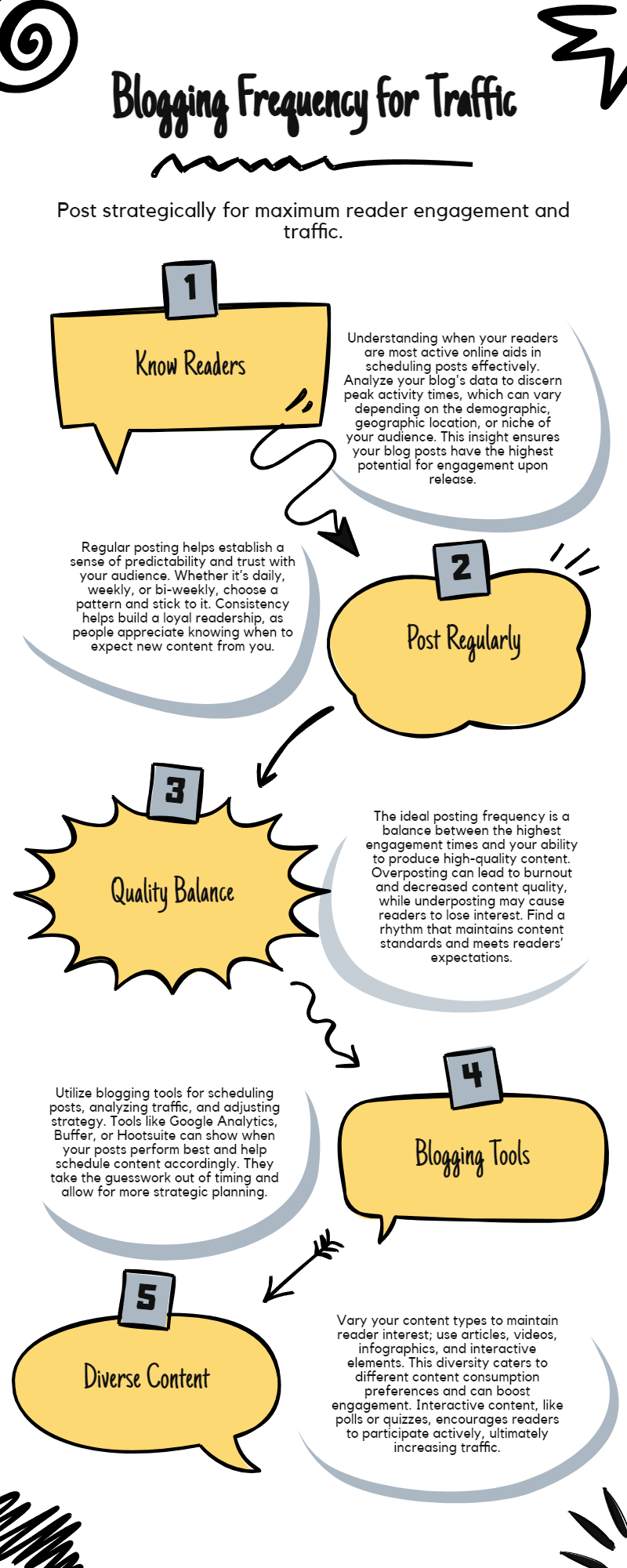
To get the most visitors to your blog[2], it’s all about finding the sweet spot between what your readers want and what you can consistently deliver. Regular, high-quality posts are key. They not only keep your readers coming back, they also help your blog climb higher in Google[3]’s search rankings.
Using data like the times when your blog gets the most traffic and how your readers behave can help you plan when to post. Tools like WordPress and a good old-fashioned content calendar can help you stay organized. Keeping an eye on your blog’s performance can give you useful feedback on what’s working and what’s not.
But remember, it’s critical to balance the number of posts you’re putting out with your ability to keep producing top-notch content. Want to know more about how to supercharge your blog traffic with a mix of content types? Stay tuned…
And remember, there is no one-size-fits-all solution. It’s a journey of trial and error. Stay tuned for our next post on how to measure your blog’s performance.
Diving into blog post timing, it’s clear that how often and when you post matters a lot. It can make or break your blog’s popularity and success. Posting on a schedule, for instance, can create excitement and anticipation among your readers. This helps you build a dedicated group of followers over time.
Why? Because when you share good content regularly, people get used to checking your blog. This can speed up their journey from just a visitor to a buyer. Plus, Google’s behind-the-scenes rules favor regular and valuable content. This means keeping a steady posting rhythm can help your blog climb the Google ranking ladder.
To make your blog work best for you, it’s key to look at what your readers are doing. This means checking when most people visit your site, knowing who they are, seeing what catches their attention, and keeping an eye on how they interact with your posts on social media.
Using these high-traffic times to your advantage can help you decide when to post. Getting to know your readers’ background and likes can help shape what and when you post. How many clicks your posts get, and how long people stay, can show you what grabs their interest. The shares and comments you get on social media tell you how engaged your readers are and what they’re interested in. And surveys? They’re a great way to really get to know what your readers like.

Make sure to check your Google Search Console[1] for insights and install Microsoft Clarity for free heatmaps to see how long readers stay on your page, where they click , interact, etc.
What happens when you put all these methods into action? Stay tuned to find out.

I
Knowing how to post effectively is key to making your blog more visible, engaging, and beneficial to your sales process. A steady routine of frequent blog posts can significantly increase organic traffic – that’s because search engines love regular, high-quality content.
But how often you should post? That depends on how your audience responds and your capacity to keep producing good content. A content calendar is a handy tool for planning a solid content strategy and sticking to a regular posting routine. This can help your brand become better known, as your audience starts to look forward to your regular posts.
Let’s chat about how you can measure how well your blog is doing. Think of it like a report card for your blog.
The number of views and unique visitors can tell you how many people are stopping by. The bounce rate and time spent on your blog can show if they’re actually reading your posts or merely clicking away.
Are people sharing your posts on social media? Are they clicking on links you provide? These actions show that your blog is getting people to do something.
Where does your blog appear when people search for relevant keywords? Are other sites linking back to your blog? These factors can tell you if your blog is easy to find on search engines.
Keep an eye on these measurements and tweak your blogging strategy to keep your audience coming back for more. But what if you’re still struggling to boost your blog’s performance? Stay tuned to discover some secret tips.
If the thought of keyword research and content optimization feels overwhelming, we’re here to help. Our specialists are ready to tailor an SEO strategy that fits your unique needs and goals. Get in touch with us now via our contact page or chat with us instantly on WhatsApp for quick, professional assistance.
Using blogging tools like WordPress, Squarespace, and Wix can make your blogging journey simpler. These tools help keep your posts looking consistent and boost your blog’s performance using built-in analytics. Planning your posts ahead of time? These tools have got you covered. They let you schedule posts for specific dates and times, keeping your blog active and your readers hooked. You can even draft and save posts for later, making things easy and handy for you.
Moreover, these tools come with an analytics feature. It lets you see how your posts are doing and tweak your posting times based on what the data tells you. In simple words, these blogging tools can help bring more people to your blog. But, how exactly do they do this? Stay tuned to find out.
If you’re looking to get more people to visit your blog, consider diversifying the kinds of content you put up. By mixing it up and appealing to a broader range of interests, you could see a boost in how many people are checking out your blog.
Here’s how you can do it:
Firstly, try including infographics and number-based facts in your blog posts. They’re not just easy to understand, but they’re also more likely to catch your reader’s eye.
Secondly, shake up the format of your content. Think about inviting guest writers, interviewing experts, sharing videos, and even starting a podcast. By doing this, you’re more likely to reach new people who might not have found your blog otherwise.
Lastly, why not make your blog more interactive? By adding quizzes, polls, or surveys, you’re giving your readers a chance to engage with your content. This can help to increase the number of people visiting your blog.
Blogging success doesn’t just happen overnight. It’s a mix of several key ingredients. First, you need top-notch content that grabs attention. Next, your readers need to be actively involved, commenting and sharing your posts. Don’t forget about SEO – those fancy terms that help your blog pop up in search engine results.
Also, you need to be savvy on social media, posting and promoting your blog to reach a wider audience. Collaborating with influencers in your field and guest blogging on their platforms can also boost your blog’s visibility.
Writing long posts packed with useful info, and spicing it up with videos, images, and other multimedia can make your content more appealing. But perhaps the most important thing is consistency. You need to blog regularly, but how often? Well, that depends on your blog’s topic and your audience.
To get more eyes on your blog, try to write 3 to 4 articles each week. Don’t just focus on quantity, though. Make sure every piece is top-notch, engages your readers, and includes SEO tricks. Promote your posts on social networks, use keywords wisely, and stick to a regular schedule. All your content should be engaging, relevant to your niche, and encourage interaction. Interested in knowing more? Stay tuned for more tips on how to increase your blog traffic.
The best plan for publishing blog posts is a delicate mix. It’s about regular posts, keeping your readers hooked, and making Google happy. You should focus on creating top-notch content instead of just pumping out articles. Taking care not to burn out is key, and sticking to your writing schedule is crucial. What you write about should fit your blog’s theme, and sharing your posts on social media can help keep your readers coming back for more. But remember, what’s the magic formula behind this strategy? Stay tuned for our next post to find out.
The perfect number of blogs to post each month isn’t set in stone. It hinges on a few things. First, the quality of what you’re writing matters, as does how much your readers interact with your posts. The way you use search engine optimization (SEO) techniques, the relevance of your topic, and how you promote your blog also play a part.
If you’re juggling varied types of content, like long and short articles or guest posts, you’ll keep your readers interested. Regular updates and timeless content that’s always useful can help keep them coming back for more.
